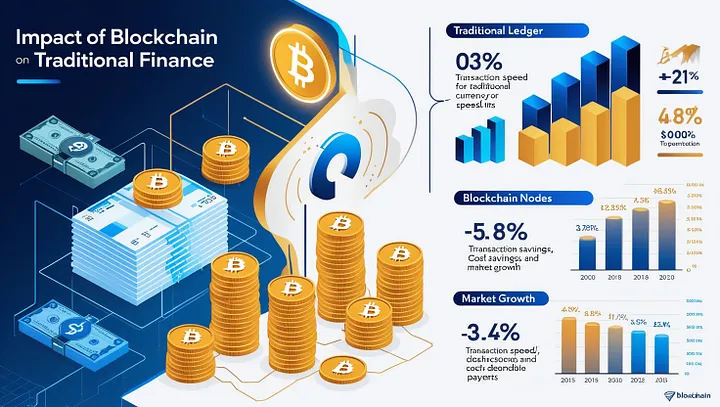Blockchain technology is transforming traditional finance by introducing transparency, security, and efficiency. This article explores how blockchain is disrupting industries such as banking, payments, and investments, paving the way for a decentralized financial future.
The Emergence of Blockchain and Its Impact on Finance
In the last decade, blockchain technology has emerged as one of the most disruptive innovations in the financial sector. Often associated with cryptocurrencies like Bitcoin, blockchain has potential applications far beyond digital currencies. It is a decentralized, distributed ledger technology that records transactions across multiple computers in a secure and transparent manner.
The Flaws in Traditional Finance
Traditional financial systems, while highly developed, are plagued by inefficiencies, high costs, and centralization. Banks and financial institutions act as intermediaries, controlling access to financial services and often charging hefty fees for their services. Additionally, the centralized nature of these systems makes them vulnerable to fraud, hacking, and corruption.
Moreover, the process of transferring money internationally can take days and involves multiple intermediaries, leading to delays and increased costs. This is particularly challenging for underserved populations who lack access to traditional banking services.
How Blockchain Addresses These Issues

Blockchain technology offers a bold solution to these challenges. By eliminating the need for intermediaries, blockchain enables peer-to-peer transactions that are faster, cheaper, and more secure. Here are some key ways blockchain is disrupting traditional finance:
Transparency and Trust
Blockchain’s decentralized ledger ensures that all transactions are recorded in real-time and are immutable. This transparency builds trust between parties, reducing the need for intermediaries and fostering a culture of accountability.
Security
Blockchain uses advanced cryptographic techniques to secure transactions, making it extremely difficult for hackers to tamper with the system. Unlike traditional systems that rely on centralized databases, blockchain’s decentralized nature distributes data across a network, reducing the risk of a single point of failure.
Efficiency
Blockchain streamlines processes by automating tasks that were previously manual and time-consuming. For example, smart contracts—self-executing contracts with the terms directly written into code—can automatically execute agreements when predefined conditions are met. This reduces the need for manual intervention, cutting costs and improving efficiency.
Financial Inclusion
Blockchain has the potential to bring financial services to the unbanked and underbanked populations. With a smartphone and an internet connection, individuals can access decentralized financial (DeFi) platforms, allowing them to participate in global financial markets without relying on traditional banks.
The Rise of Cryptocurrencies
One of the most visible manifestations of blockchain’s impact on finance is the rise of cryptocurrencies. Bitcoin, the first decentralized digital currency, was created to challenge the dominance of central banks and traditional financial institutions. Since its inception in 2009, the cryptocurrency market has grown exponentially, with thousands of coins and tokens now in circulation.
Cryptocurrencies offer several advantages over fiat money. They enable fast and cheap cross-border transactions, and they provide a hedge against inflation in countries with unstable economies. However, they also come with risks, such as price volatility and regulatory uncertainty. Despite these challenges, cryptocurrencies are here to stay and are forcing traditional financial institutions to rethink their strategies.
Blockchain in Banking and Payments
The banking sector is one of the most conservative industries, but even banks are beginning to recognize the potential of blockchain. Leading institutions are investing in blockchain technology to improve their payment systems, reduce costs, and enhance security. For example, blockchain-based payment platforms like Stellar and Ripple are enabling faster and cheaper cross-border payments, bypassing the need for correspondent banking.
In addition, central banks around the world are exploring the concept of central bank digital currencies (CBDCs). These digital versions of fiat currencies could streamline monetary policy implementation and reduce the risks associated with fiat money.
The Future of Investment and Trading
Blockchain is also disrupting the investment and trading landscape. Decentralized exchanges (DEXs) allow users to trade cryptocurrencies directly without relying on centralized exchanges, reducing the risk of hacks and censorship. Moreover, blockchain-based platforms are enabling tokenization, where physical assets like real estate, art, and commodities can be represented as digital tokens. This makes these assets more liquid and accessible to a global audience.
Furthermore, blockchain is revolutionizing fundraising through initial coin offerings (ICOs) and security token offerings (STOs). These innovative funding mechanisms allow startups to raise capital directly from the public, bypassing the traditional venture capital model.
The Road Ahead for Blockchain and Finance
As blockchain technology continues to evolve, its impact on traditional finance is expected to grow even more significant. However, challenges remain, and the path to widespread adoption is not without obstacles.
Overcoming Regulatory Hurdles
One of the biggest challenges facing blockchain adoption is regulatory uncertainty. Governments and regulatory bodies are still grappling with how to classify cryptocurrencies and govern blockchain-based systems. In some jurisdictions, strict regulations have stifled innovation, while in others, a lack of clarity has created uncertainty.
To achieve mainstream adoption, the blockchain industry must work closely with regulators to develop frameworks that balance innovation with consumer protection. This includes addressing issues such as money laundering, tax evasion, and investor protection.
Scalability and Interoperability
Another challenge is scalability. While blockchain technology offers significant advantages, many systems struggle to handle large volumes of transactions efficiently. This has led to network congestion and high transaction fees, particularly on popular platforms like Ethereum.
Efforts are underway to address these issues through advancements in sharding, layer-2 solutions, and other scalability techniques. Additionally, interoperability between different blockchain networks is essential for the technology to reach its full potential.
The Role of institutions
Traditional financial institutions play a critical role in the adoption of blockchain technology. While some banks and corporations are embracing blockchain, others remain skeptical, citing concerns about security, regulation, and integration with legacy systems.
Collaboration between industry players, regulators, and blockchain developers will be key to driving widespread adoption. This includes investing in research and development, fostering innovation, and educating stakeholders about the benefits of blockchain.
The Promise of Decentralized Finance (DeFi)
Decentralized finance, or DeFi, is one of the most promising applications of blockchain technology. DeFi platforms aim to recreate traditional financial instruments, such as loans, insurance, and trading, without relying on centralized intermediaries.
DeFi has already gained significant traction, with platforms like MakerDAO, Compound, and Aave enabling users to borrow, lend, and trade cryptocurrencies directly on the blockchain. These platforms have demonstrated the potential of blockchain to democratize access to financial services and empower individuals.
However, DeFi also comes with risks. The lack of regulatory oversight in many jurisdictions has led to instances of fraud and hacks. To address these issues, the DeFi community must prioritize education, transparency, and robust security measures.
Blockchain and Sustainability
Blockchain technology also has the potential to contribute to a more sustainable future. By enabling transparent and efficient supply chains, blockchain can help combat issues such as counterfeit goods, deforestation, and human rights violations. In the financial sector, blockchain can play a role in promoting green finance by facilitating the tracking and trading of carbon credits and other environmental assets.
Moreover, blockchain-based solutions can empower individuals and communities by enabling direct participation in decision-making processes. For example, blockchain governance models allow stakeholders to vote on important decisions, ensuring greater inclusivity and accountability.
The Human Element
While blockchain technology offers immense potential, it is ultimately a tool created and controlled by humans. The success of blockchain in disrupting traditional finance will depend on the ability of individuals and organizations to adapt to these changes. This includes embracing new ways of thinking, collaborating across industries, and fostering a culture of innovation.
In conclusion, blockchain technology is poised to revolutionize the financial landscape by introducing new levels of transparency, security, and efficiency. While challenges remain, the potential benefits are too significant to ignore. As the world continues to embrace blockchain, we can expect to see a financial system that is more inclusive, sustainable, and user-centric. The future of finance is decentralized, and blockchain is at the heart of this transformation.
This concludes the two-part article on how blockchain is disrupting traditional finance.
